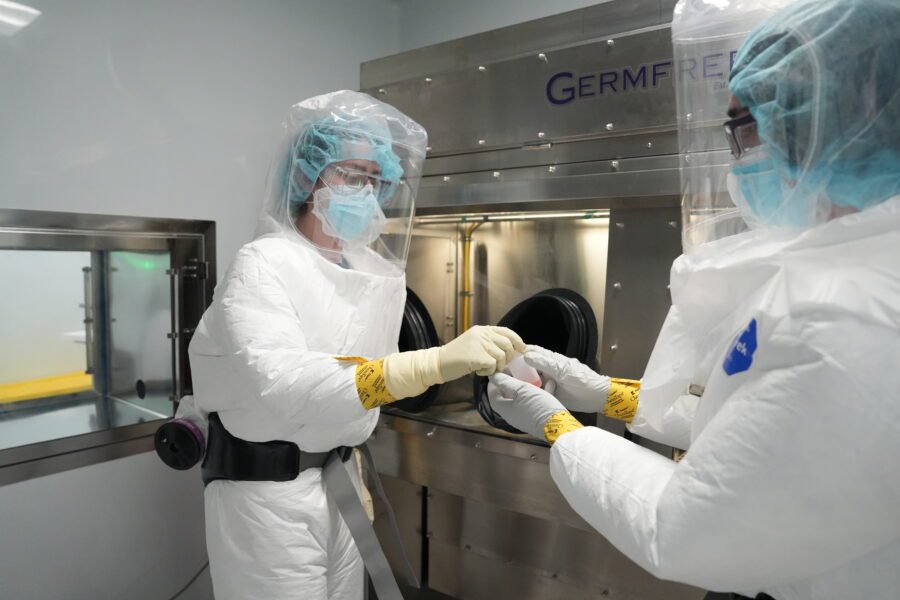Why Abzena?
Our focused approach.
Antibody-drug conjugates (ADCs) are at the forefront of targeted cancer therapy. They combine the precision of monoclonal antibodies (mAbs) with the potency of cytotoxic drugs to destroy cancer cells, without harming healthy tissue.
ADCs provide a wide therapeutic index — the range of drug dosages that can be administered without toxic side effects — of cytotoxic drugs by selectively delivering them to cells expressing specific antigens targeted by the mAbs. The efficacy of ADCs depends on antibody-specific, linker-specific and payload-specific factors interacting with the tumor and its microenvironment.
At least 13 ADCs have been approved by the US Food and Drug Administration (FDA) to treat a wide range of cancers cancers, including breast cancer, B-cell lymphoma, urothelial cancers and more, and there is an acceleration ADC entering Phase III clinical trials.
In a one-on-one with Xtalks, Dr. Petra Dieterich, Senior Vice President and Scientific Leader at Abzena, shared her comprehensive insights into the sophisticated world of ADCs and their evolving role in cancer treatment. Dr. Dieterich has a PhD in synthetic organic chemistry, an MBA from Imperial College London and a wealth of experience in drug development and chemistry, manufacturing and control (CMC) activities.
Abzena is a leader in bioconjugation and ADC development. They excel in the design and synthesis of complex small molecule, high potent chemistry and payload-linker constructs, supporting the rapid generation of structure-activity relationships (SAR) to identify the most suitable structures for specific ADC profiles.
The design of an ADC requires careful consideration of three components — an antibody targeting a specific antigen on cancer cells, a cytotoxic drug (payload) and a linker connecting the two — to ensure specificity, efficacy and safety. Dr. Dieterich elaborated on the critical aspects of each component: “There’s the protein part, a small molecule and then there’s the linker part in the middle.” Upon binding to the target antigen on the tumor cell surface, the ADC is internalized, and the linker is cleaved, releasing the cytotoxic payload to induce cell death.
For the antibody component, the specificity of tumor cells is paramount. “We want to be targeting receptors that are specific to tumor cells. We want our antibody to have a long half-life in circulation and we want it to be retained in the circulation,” she explained. This targeting ensures the antibody can effectively deliver the toxic payload to the cancer cells without affecting normal cells.
Dr. Dieterich emphasized the importance of the payload’s chemical properties and its mechanism of action. The payload itself needs to be exceptionally toxic and potent. “We have to have a very highly potent payload. We want our payloads to be hydrophobic enough. If there is an opportunity to elucidate the bystander effect [where a cell responds to an event in the same way as the adjacent cell undergoing the event], it can diffuse into neighboring cancer cells and kill those for us as well,” said Dr. Dieterich.
The linker — cleavable or non-cleavable — that connects the antibody to the payload is equally vital, affecting the stability and release of the payload: “The chemistry that we use really defines the structure of our final ADC and how the loading of that antibody-drug ratio looks,” said Dr. Dieterich. Linkers need to be stable in blood circulation to ensure that there isn’t any shedding of the payload, risking toxicity. It is important to demonstrate that the ADC is safe and effective at killing target cells to ensure a successful regulatory submission.
ADC development, while promising, is not without its challenges. Dr. Dieterich identified two primary hurdles: drug resistance and adverse-events. She uses the case of Enhertu (trastuzumab deruxtecan), a leading ADC for treating metastatic breast cancer, to illustrate these issues. “Enhertu’s the poster child amongst ADCs right now, it’s got pan-tumor potential and it’s really been extremely successful in combating breast cancer. Metastatic breast cancer response rates in clinical trials are up to 75 percent, but even there we’re seeing some significant issues with interstitial lung disease in about nine percent of patients,” she stated.
Enhertu is a HER2 (human epidermal growth factor receptor 2)-directed ADC that targets HER2-expressing cancer cells. It combines an HER2 monoclonal antibody with a potent topoisomerase I inhibitor (exatecan derivative or DXd) via a cleavable linker. Data from AstraZeneca’s DESTINY-Breast03 and DESTINY-Breast07 trials highlight Enhertu’s potential as a first line standard of care for HER2-positive metastatic breast cancer.
Dr. Dieterich suggested that increased adverse effects can often be attributed to drug resistance mechanisms driven by tumor heterogeneity, which changes how drugs work against the tumor. These changes in the tumor environment help the tumor resist treatment by modifying gene activity, avoiding immune detection and supporting survival pathways. As the tumor grows and adapts, its surrounding environment becomes better at resisting the effects of treatment, creating major challenges for effectively targeting the cancer.
“Drug resistance is really the root of this, and it’s brought about by tumor heterogeneity, and the different responses to treatment are caused by the different strains in the cancer having different responses to the ADCs. That leads to resistant strains and then [the] treatment stops working,” she said. Dr. Dieterich alluded to the initial discontinuation of the drug Mylotarg (gemtuzumab ozogamicin) due to its high fatal toxicity rate as compared to chemotherapy. However, it has since been authorized for use under different treatment regimens and with boxed warnings.
